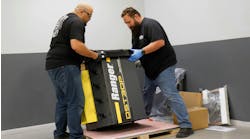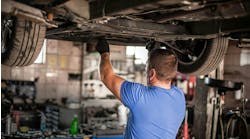First steps
PIRM’s Beltran recommended that the first step for a shop is to ensure that they are compliant with OSHA requirements and NFPA recommendations for vehicle repair shops, mentioning that on top of the actual fire safety benefits, this helps avoid violations and fines during inspection. It’s also important to comply with any local fire code requirements.
Abiding by regulations is a good start, but as technicians know, it takes more than rules and SOPs to get things done.
Calling a local fire department and asking for guidance is the next best step, Beltran suggested, emphasizing that they are usually willing to come let a shop know what might be missing from their fire-prevention plan and what they should pay attention to, as proactivity is always better than having to come put out a fire.
The experts agreed that shops often run into a few of the same mistakes when implementing fire-proofing measures and addressing hazards, one of which is lack of or inadequate employee training on identifying and fighting fire.
“It’s mandatory by federal and state OSHA programs that vehicle technicians and staff should absolutely receive training on fire prevention and firefighting,” Beltran said, “including the ability to identify different types of fires and how to properly extinguish them using appropriate methods.”
Training doesn’t have to be stressful, however, and again, local fire departments can help instruct employees on how to respond in the event of fire, including how to use extinguishers.
“Having the extinguisher is one thing, but not being able to use it correctly and not being trained on it sometimes makes things worse,” said Capt. Mike Daley, chief training officer and fire officer with Fire Service Performance Concepts, “and if you grab the wrong extinguisher for the wrong kind of fuel, it can also make things worse.”
There are also a whole host of potential issues that shop personnel may not even be aware of, and things like improper placement of fire alarms, neglecting regular maintenance, not addressing blocked exits, using extension cords improperly, failing to update fire protection systems, and more are not uncommon to encounter when inspecting a shop, according to Beltran.
The easy solution here is to leave things to the experts, and luckily, most fire departments are available to lend a helping hand beyond just training.
“Are the extinguishers checked every month? Is extinguisher training done annually? Are they up to date? Are they filled? Have they been inspected?” asked Daley, who was a diesel mechanic for 20 years. “There are lots of shops and repair facilities that are really diligent on that stuff, and unfortunately, I’m sure there are a few that sneak by and aren’t.”
Shop managers already have plenty on their plate, and requesting training and inspection from those who know exactly what to look for is the best way to prevent hazards from slipping through the cracks.
“I think people want to comply, but they don’t know what they don’t know. And I think that that’s our job as the fire service to educate them,” Cowan offered. “I think if we can bridge that gap between the fire service and fleet managers and mechanics and shops to say, ‘This is why this is important,’ I think you got it licked after that point.”
Know the drill
Preparation is great, but what happens if a fire happens? Have a plan. Managers should ensure that their employees know the drill, literally.
“Are they training their employees to use fire extinguishers, or are they just training their employees to get out? How do they mass notify their people?” Cowan asked. “I’ve seen some dealerships have 40 bays and if a fire starts on one end, how do you communicate that to the other end?”
These are all things that should be part of a concrete plan, but the best first step to take when disaster strikes is call 911, even if you think the situation might be under control.
“Even if it’s a flash fire that the shop technicians might have put out, fire departments are carrying thermal imaging devices and other devices that can confirm that temperatures are down and the fire is completely out,” Daley explained.
The next thing, Cowan said, is to think about others who may be in danger. For example, a showroom full of customers connected to the shop.
“Let’s say it’s a dealership,” he posed. “Now we’ve got to do some evacuation.”
The rest may vary based on the size of the shop, layout, where the fire is, how quickly it is spreading, etc.
Daley discussed a situation in which a fire started just outside of a repair shop, and quick thinking by the technicians present helped mitigate the situation.
“One of the smartest things that the shop did was close the bay doors, so that the fire was already outside and stayed outside instead of coming into the building.”
However, acting impulsively can have unintended consequences, making things worse. Daley mentioned another example of technicians doing their best to mitigate a fire that didn’t help the situation overall.
“It was a fuel tank that started to burn, and as it was moved, the fuel started to spill and the fire started to spread,” he recalled. “So again, the best thing to do is just call the fire department.”
The bottom line is that for things to go as smoothly as possible if an emergency situation arises and to keep damage to a minimum, managers should make sure it’s not the first time they’re talking about fire safety with their employees.
“All that promulgation of practicing fire safety and actually going through this with their employees pays off in dividends when something happens,” Cowan concluded.






